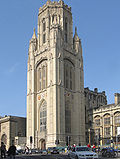Centre For Device Thermography And Reliability
The institute gets funding from various government and private sector sources, such as European Space Agency and Engineering and Physical Sciences Research Council.
Solid state device research
The H.H. Wills Physics Laboratory, named after Henry Herbert Wills, is the home of the department of Physics of the university. Former heads of department include Sir Charles Frank (crystal growth, liquid crystals) and Nobel Laureates C. F. Powell (whose discovery of the π meson marked the birth of modern particle physics), and Sir Nevill Mott. The Aharonov-Bohm effect and the Berry phase are also Bristol discoveries. The School carries out research in the fields of Astrophysics, Correlated Electron Systems, Micro and Nanostructural Materials, Nanophysics and Soft Matter, Particle Physics, Quantum Photonics and Theoretical Physics. The school is a principal stakeholder in the university's £11 million Centre for Nanoscience and Quantum Information and the £3 million Centre for Device Thermography and Reliability. The laboratory is one of the quietest laboratories in the world.

Research
The centre carries out in research in the following areas.
- Microwave and Power electronic devices
- Thermal management research
- Electronic Device Performance and Reliability
- Device Simulation
References
- ^ "Annual report and financial statements 2012/13" (PDF). University of Bristol. Archived from the original (PDF) on 12 January 2014. Retrieved 10 September 2014.
- ^ "Maps and Guides". The University precinct map. Retrieved 10 September 2014.
- ^ "The University of Bristol". Worldwide Universities Network. Archived from the original on 11 September 2014. Retrieved 10 September 2014.
- ^ Sarua, A (7 July 2008). "Raman-IR micro-thermography tool for reliability and failure analysis of electronic devices". 2008 15th International Symposium on the Physical and Failure Analysis of Integrated Circuits. Proc. Physical and Failure Analysis of Integrated Circuits, 2008. pp. 1–5. doi:10.1109/IPFA.2008.4588160. ISBN 978-1-4244-2039-1. S2CID 2890666.
- ^ Handy, Jim (13 November 2011). "The End of Semiconductor Scaling". Forbes. Retrieved 16 September 2014.
- ^ "Funding". School of Physics | University of Bristol. Archived from the original on 21 September 2020.
- ^ "University of Bristol". Shanghai Ranking. Academic Ranking of World Universities. Archived from the original on 22 September 2014. Retrieved 16 September 2014.
- ^ "'Quietest building in the world' officially opens". Capita Symonds. 7 September 2009. Archived from the original on 6 April 2012. Retrieved 8 November 2011.
- ^ Banks, Michael (9 September 2009). "Visiting the quietest building in the world". Physics World. Institute of Physics. Retrieved 10 November 2011.
- ^ "Research areas". School of Physics | University of Bristol. Archived from the original on 19 December 2022.
